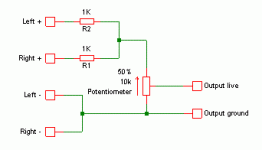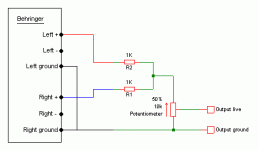Hi,
I’m new to the forum and fairly new to audio electronics.
I am in need of some help, I have built a dub sound system with a mate of mine and am now in the process of making a rack mounted volume control to control the level of the bass without having to adjust the two volume channels on the power amp.
We run everything in mono.
The volume wheel I am making is to be placed in-between the limiter/crossover and amp. I have a left and right channel I need to put into it, so I was thinking with it being in mono just attaching the +L input to +R and –L to –R, leaving two inputs I need to send to the pot, (and obviously the same for the output.)
Could someone please tell me the best way to wire the pot?
(I think I have looked into it too much and all the different ways of wiring them have just been moulded together in my mind.)
I understand as much as point 1 on the pot is ground, 2 out and 3 in, but what does one do when there are two poles to send into it and out of it??
Any help would be greatly appreciated!!
Joe
I’m new to the forum and fairly new to audio electronics.
I am in need of some help, I have built a dub sound system with a mate of mine and am now in the process of making a rack mounted volume control to control the level of the bass without having to adjust the two volume channels on the power amp.
We run everything in mono.
The volume wheel I am making is to be placed in-between the limiter/crossover and amp. I have a left and right channel I need to put into it, so I was thinking with it being in mono just attaching the +L input to +R and –L to –R, leaving two inputs I need to send to the pot, (and obviously the same for the output.)
Could someone please tell me the best way to wire the pot?
(I think I have looked into it too much and all the different ways of wiring them have just been moulded together in my mind.)
I understand as much as point 1 on the pot is ground, 2 out and 3 in, but what does one do when there are two poles to send into it and out of it??
Any help would be greatly appreciated!!
Joe
Hi,
I’m new to the forum and fairly new to audio electronics.
I am in need of some help, I have built a dub sound system with a mate of mine and am now in the process of making a rack mounted volume control to control the level of the bass without having to adjust the two volume channels on the power amp.
We run everything in mono.
The volume wheel I am making is to be placed in-between the limiter/crossover and amp. I have a left and right channel I need to put into it, so I was thinking with it being in mono just attaching the +L input to +R and –L to –R, leaving two inputs I need to send to the pot, (and obviously the same for the output.)
Could someone please tell me the best way to wire the pot?
(I think I have looked into it too much and all the different ways of wiring them have just been moulded together in my mind.)
I understand as much as point 1 on the pot is ground, 2 out and 3 in, but what does one do when there are two poles to send into it and out of it??
Any help would be greatly appreciated!!
Joe
Hi Joe
The traditional circuit is for attenuation ( reduction in volume ) is called an L pad which is a voltage divider. As one wiper traverses in one direction the other does the opposite. We call the two parts of an L pad , one is Series ie that resistance that connects the source via variable resistance to a summing point, from that summing point which is the output, the next part is called Shunt that varies resistance as well before it goes to ground, the two poles are likely to be there to assist this direction change.
If you have access to a multimeter you can measure the way each connection is going with switching your meter to Ohms. If we join the wiper the central connector (2) to 1 and observe the resistance change on 3, we have the pot working to suit in one direction. So the other needs to be (2) and 3 joined and the connection on 1 gives us resistance but heading in the opposite direction.... just what we need for an L pad.
See:Uneeda Audio - Build your own attenuator pads
You will find these same circuits being used in somewhat naughty Speaker use, however the wattage is much much higher. In speaker use, they are sacrificing audio quality, as the amplifier for audio has enough to do, let alone contending with variable resistances. and L pads are used in very high frequency circuits with very specific resistance.
Cheers / Chris
Last edited:
That should be fine. To be sure, you could include a low value resistor in the +L and +R feeds but in most cases the previous stage will include these in its output anyway.RRSS said:so I was thinking with it being in mono just attaching the +L input to +R and –L to –R, leaving two inputs I need to send to the pot, (and obviously the same for the output.)
Cheers for the input guys!
So if I soulder the + wire to point 3 on the pot, what do I do with the - wire? Do I treat it as the earth? or do I bypass the pot with it completely?
Hi Godfrey, The limiter is a crossover as well, (Behringer DCX2496) so if the volume control was before it, it would alter the volume of all 3 crossover channels, it is just the bass I am looking to be able to adjust.
Cheers,
Joe.
So if I soulder the + wire to point 3 on the pot, what do I do with the - wire? Do I treat it as the earth? or do I bypass the pot with it completely?
Agree with DF96. Maybe use a 10K log potentiometer and 1K resistors.
One other thing, though. I'm not really familiar with this kind of equipment, but shouldn't the limiter go after the volume control?
Hi Godfrey, The limiter is a crossover as well, (Behringer DCX2496) so if the volume control was before it, it would alter the volume of all 3 crossover channels, it is just the bass I am looking to be able to adjust.
Cheers,
Joe.
Hi
I meant to wire it up like in the pic below.
This is assuming that the equipment has single ended inputs and outputs (e.g. with RCA connectors). In that case L- and R- are both earth connections.
If it's balanced (e.g. with XLR connectors), then the story gets more complicated.
edit: Drat, I looked up the Behringer DCX2496, and it only has balanced outputs. I'll post plan B in a few minutes.
I meant to wire it up like in the pic below.
This is assuming that the equipment has single ended inputs and outputs (e.g. with RCA connectors). In that case L- and R- are both earth connections.
If it's balanced (e.g. with XLR connectors), then the story gets more complicated.
edit: Drat, I looked up the Behringer DCX2496, and it only has balanced outputs. I'll post plan B in a few minutes.
Attachments
Last edited:
I think the easiest will be to just use the "+" outputs from the Behringer, and leave the "-" outputs unconnected, unless someone else has a better idea.
Depending on the Behringer's circuitry, it might work better if you put a resistor from each "-" output to ground as well. Resistors only cost a few pence for a bag of 10, so experimentation is (financially) painless.
Depending on the Behringer's circuitry, it might work better if you put a resistor from each "-" output to ground as well. Resistors only cost a few pence for a bag of 10, so experimentation is (financially) painless.
Attachments
Last edited:
If the Behringer has genuine balanced circuitry, then probably no as the '-' has to take the signal return current. If only pseudo-balanced then it should be OK. On cheap semi-pro gear 'balanced' is often only pseudo-balanced.
If it is only a short connection in a benign low-noise environment then you can may get away with an unbalanced volume pot in a 'balanced' connection: just treat '-' as ground for the pot.
If it is only a short connection in a benign low-noise environment then you can may get away with an unbalanced volume pot in a 'balanced' connection: just treat '-' as ground for the pot.
- Status
- This old topic is closed. If you want to reopen this topic, contact a moderator using the "Report Post" button.
- Home
- Design & Build
- Construction Tips
- Potentiometer as a volume control

